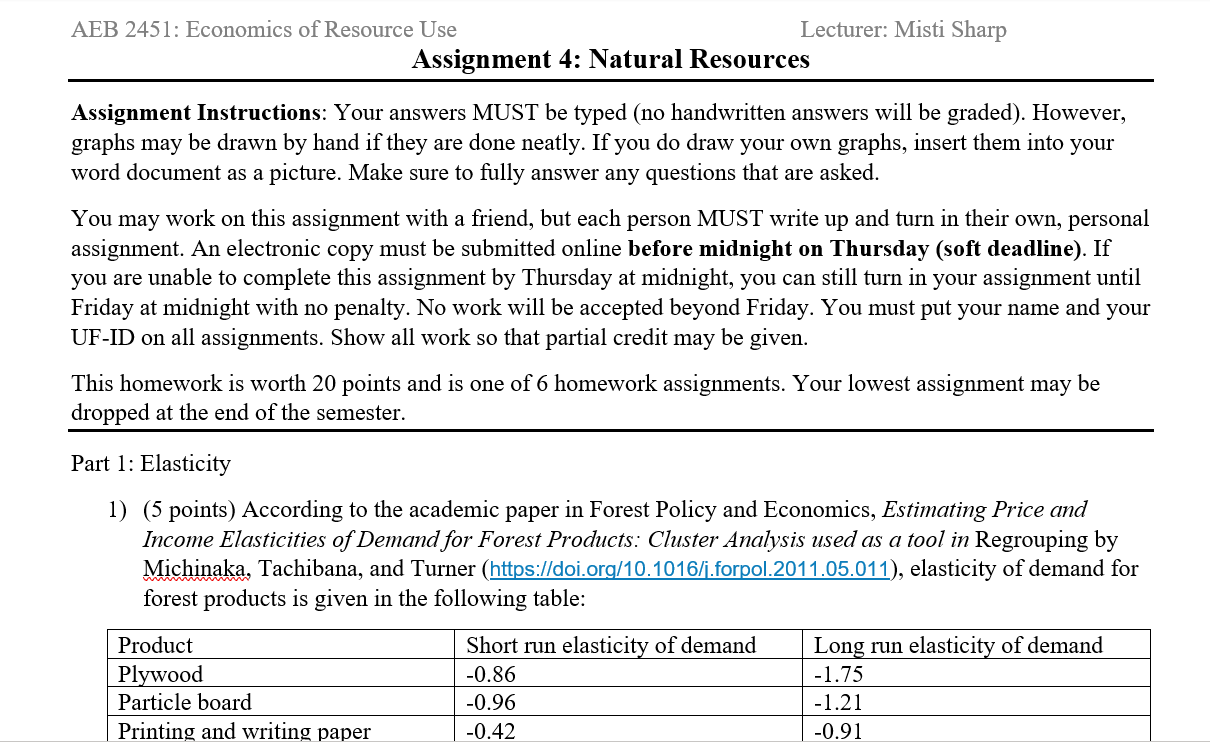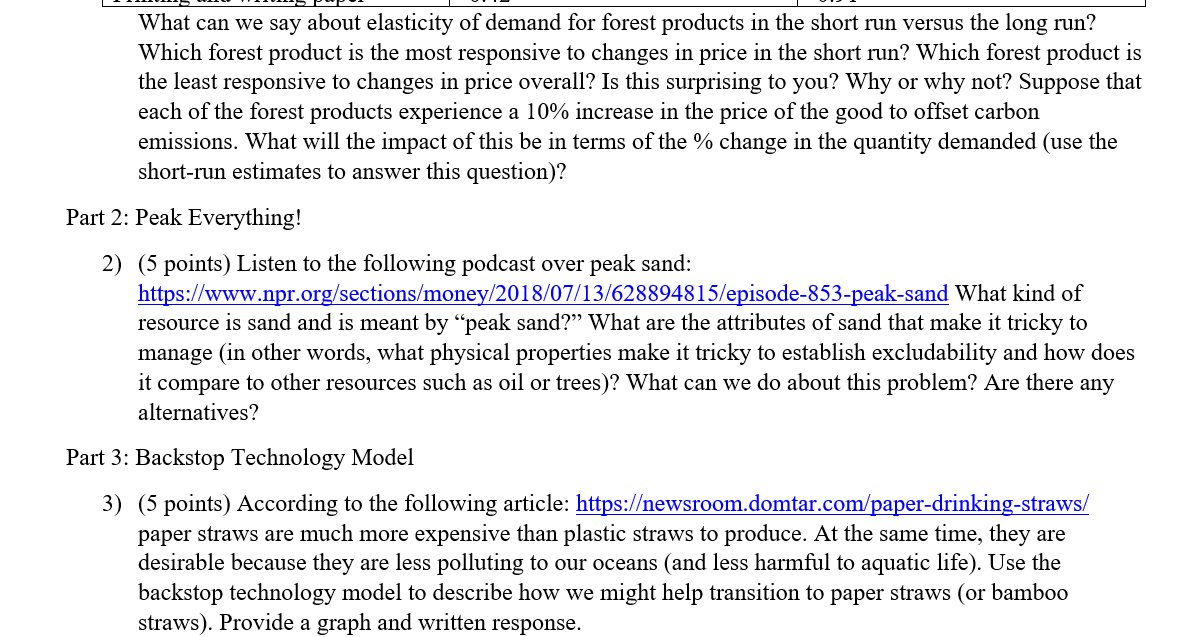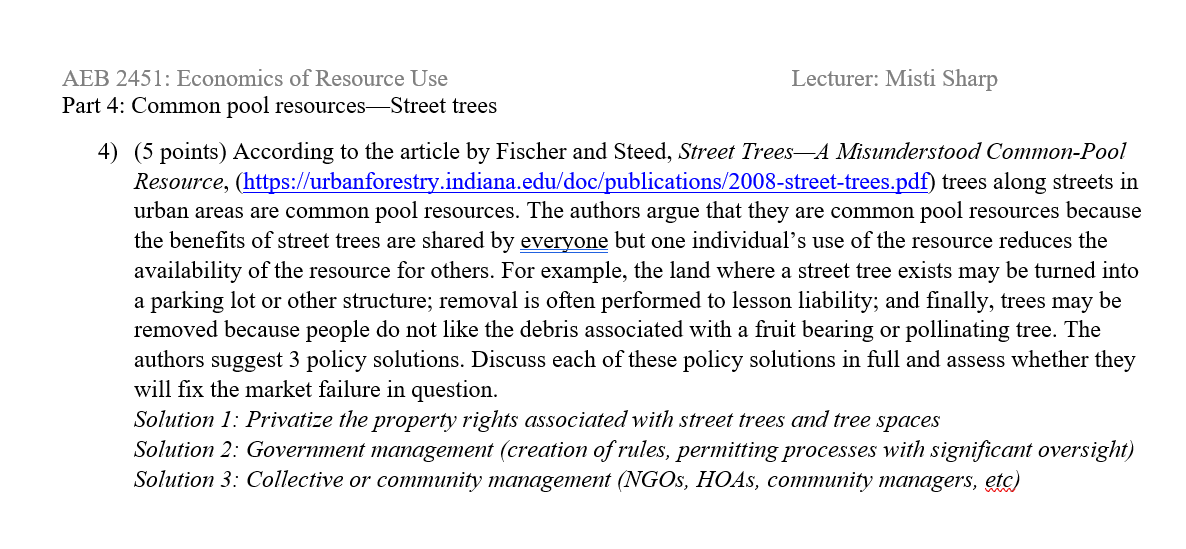I hope this uploads properly
AEB 2451: Economics of Resource Use Lecturer: Misti Sharp Assignment 4: Natural Resources Assignment Instructions: Your answers MUST be typed (no handwritten answers will be graded). However, graphs may be drawn by hand if they are done neatly. If you do draw your own graphs, insert them into your word document as a picture. Make sure to fully answer any questions that are asked. You may work on this assignment with a friend, but each person MUST write up and turn in their own, personal assignment. An electronic copy must be submitted online before midnight on Thursday (soft deadline). If you are unable to complete this assignment by Thursday at midnight, you can still turn in your assignment until Friday at midnight with no penalty. No work will be accepted beyond Friday. You must put your name and your UF-ID on all assignments. Show all work so that partial credit may be given. This homework is worth 20 points and is one of 6 homework assignments. Your lowest assignment may be dropped at the end of the semester. Part 1: Elasticity 1) (5 points) According to the academic paper in Forest Policy and Economics, Estimating Price and Income Elasticitz'es of Demand for Forest Products: Cluster AnaIysts used as a tool in Regrouping by Michinaka Tachibana, and Turner (https:h'doi.org!1D.1016!i.forgol.201 'l .05.01 1), elasticity of demand for forest products is given in the following table: Product Short run elasticity of demand Long run elasticity of demand Plywood -0.86 -1.75 Particle board -0.96 -1.21 Printing and writing paper -0.42 0.91 | -\"\"'"'D \"'- "\"'\"'D rr" | ' _ "" ' What can we say about elasticity of demand for forest products in the short run versus the long run? Which forest product is the most responsive to changes in price in the short run? Which forest product is the least responsive to changes in price overall? Is this surprising to you? Why or why not? Suppose that each of the forest products experience a 10% increase in the price of the good to offset carbon emissions. What will the impact of this be in terms of the % change in the quantity demanded (use the short-run estimates to answer this question)? Part 2: Peak Everything! 2) (5 points) Listen to the following podcast over peak sand: https:llwww.npr.org/sect:ionsf1noneyf2018/071'13/6288948 lS/episode-853-peak-sand What kind of resource is sand and is meant by \"peak sand?\" What are the attributes of sand that make it tricky to manage (in other words, what physical properties make it tricky to establish excludability and how does it compare to other resources such as oil or trees)? What can we do about this problem? Are there any alternatives? Part 3: Backstop Technology Model 3) (5 points) According to the following article: https:Xewsroom.domtar.com/paperdrinkingstraws/ paper straws are much more expensive than plastic straws to produce. At the same time, they are desirable because they are less polluting to our oceans (and less harmful to aquatic life). Use the backstop technology model to describe how we might help transition to paper straws (or bamboo straws). Provide a graph and written response. AEB 2451: Economics of Resource Use Lecturer: Misti Sharp Part 4: Common pool resourcesStreet trees 4) (5 points) According to the article by Fischer and Steed, Street TreesA Msunderstooa' Common-Poo] Resource, (https:i/urbanforestryindiana.edufdocipublicationsi2008-streettrees.pdi) trees along streets in urban areas are common pool resources. The authors argue that they are common pool resources because the benets of street trees are shared by eveggone but one individual's use of the resource reduces the availability of the resource for others. For example, the land where a street tree exists may be turned into a parking lot or other structure; removal is often performed to lesson liability; and nally, trees may be removed because people do not like the debris associated with a fruit bearing or pollinating tree. The authors suggest 3 policy solutions. Discuss each of these policy solutions in full and assess whether they will x the market failure in question. Solution 1: Privatize the property rights associated with street trees and tree spaces Soiution 2: Government management (creation of rules, permitting processes with signicant oversight) Solution 3: Collective or community management (NGOs, HOAs, community managers, egg)









